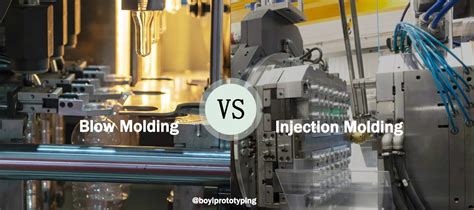Blow Molding: A Comprehensive Guide to the Injection Molding Process
Introduction
Blow molding is a versatile and widely used plastic manufacturing process that involves shaping molten plastic into hollow products. It finds applications in various industries, including automotive, packaging, and consumer goods. This article provides a comprehensive guide to blow molding, covering its principles, advantages, limitations, and applications.
Principle of Blow Molding
Blow molding involves two main steps:
-
Injection Molding: Molten plastic is injected into a closed mold cavity, forming the preform or parison.
-
Blow Molding: The preform is then transferred to a blow molding machine, where it is heated, stretched, and blown into a final shape using compressed air.
Injection Molding Process
The injection molding process in blow molding is similar to conventional injection molding. Molten plastic is injected into a mold cavity, where it cools and solidifies. However, the mold design for blow molding differs slightly. It includes a core pin or mandrel that forms the hollow interior of the product.
Blow Molding Process
Once the preform is formed, it is transferred to a blow molding machine. The machine consists of a mold and a blow pin. The following steps occur:

-
Heating: The preform is heated to its softening point.
-
Stretching: The preform is mechanically stretched and attached to the blow pin.
-
Blowing: Compressed air is introduced into the preform, causing it to expand and fill the mold's shape.
-
Cooling: The blown product is cooled to solidify the plastic.
Advantages of Blow Molding
-
Hollow Products: Blow molding allows the production of hollow products with complex shapes.
-
High Production Rates: Blow molding machines operate at high speeds, resulting in rapid production.
-
Low Material Consumption: The process utilizes only the material necessary for the product walls, reducing waste.
-
Wide Material Compatibility: Blow molding can process a variety of plastic materials, including polyethylene, polypropylene, and PVC.
-
Lightweight Products: The hollow structure makes blow molded products lightweight and easy to handle.
Limitations of Blow Molding
-
Mold Complexity: Blow mold design requires consideration of both injection molding and blow molding factors, which can increase complexity.
-
Surface Finish: The surface finish of blow molded products may not be as smooth as other molding processes.
-
Wall Thickness Limitations: Blow molding is best suited for products with relatively uniform wall thicknesses.
-
Edge Detail: Achieving sharp edges and fine details can be challenging in blow molding.
Applications of Blow Molding
Blow molding is used in a wide range of industries, including:
-
Automotive: Fuel tanks, door panels, and dashboards
-
Packaging: Bottles, jars, and containers
-
Consumer Goods: Toys, housewares, and furniture
-
Industrial Applications: Pipes, fittings, and storage tanks
Types of Blow Molding Processes
There are several different types of blow molding processes, each with its own advantages and limitations:
| Process |
Advantages |
Limitations |
| Extrusion Blow Molding |
High production rates, suitable for large products |
Limited product complexity |
| Injection Blow Molding |
Higher product complexity, better surface finish |
Lower production rates |
| Stretch Blow Molding |
Thin-walled, lightweight products |
Limited material compatibility |
How Blow Molding Matters
Blow molding is a crucial process in the plastics industry. It enables the production of lightweight, hollow products with complex shapes and high strength. According to the American Chemistry Council, the blow molding industry in the United States generates over $20 billion in annual revenue.

Benefits of Blow Molding
-
Cost Savings: Blow molding can reduce material costs compared to other molding processes.
-
Improved Product Performance: Hollow products can provide better insulation and strength-to-weight ratios.
-
Environmental Sustainability: Blow molding reduces material waste and energy consumption.
-
Increased Design Flexibility: The process allows for complex shapes and creative designs.
Effective Strategies for Blow Molding
-
Optimize Mold Design: Consider the specific requirements of both injection molding and blow molding.
-
Select the Right Material: Choose a material compatible with the blow molding process and meets the product specifications.
-
Control Process Parameters: Temperature, pressure, and cycle times play a critical role in product quality.
-
Invest in Equipment Maintenance: Regular maintenance ensures optimal machine performance and product quality.
Step-by-Step Approach to Blow Molding
-
Design the Product: Determine the desired product shape, dimensions, and material.
-
Create the Mold: Design and manufacture molds for both injection molding and blow molding.
-
Prepare the Material: Heat and mix the plastic material to the appropriate viscosity.
-
Form the Preform: Inject the molten plastic into the injection mold, forming the preform.
-
Blow the Product: Heat, stretch, and blow the preform into the blow mold to obtain the final shape.
-
Cool the Product: Allow the product to cool and solidify in the blow mold.
-
Inspect and Test: Verify product dimensions, tolerances, and performance.
Conclusion
Blow molding is a versatile and cost-effective process that plays a vital role in the plastics industry. By understanding its principles, advantages, and limitations, manufacturers can optimize their blow molding operations to produce high-quality products. Effective strategies and a step-by-step approach contribute to the success of blow molding. As the demand for lightweight, hollow plastic products continues to grow, blow molding is poised for continued growth and innovation.

